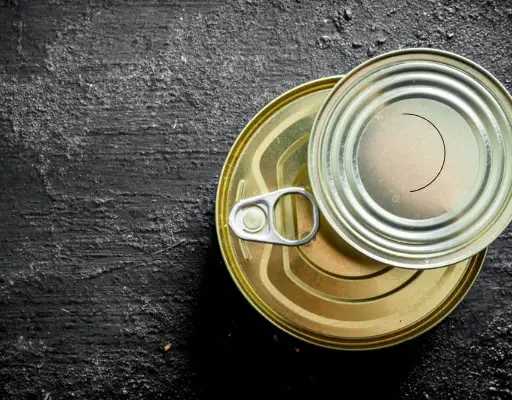In this day and age, food storage and preservation has become an essential part of our daily lives!
There’s no denying, food storage has prevented us from wasting food as well as hand us the liberty to chow down on our favorite dishes many months in the future after making them, and one particular storage technique that is especially useful for long term storage is canning — where you stuff foods inside a jar, heat em’ up and seal.!
But can you actually can mayonnaise? I mean, wouldn’t that be a game changer if it was possible? Since Mayo would easily now keep for longer than 6 months without question!
Turn down the excitement though, as the answer isn’t in the affirmative!
We’ll tell you why that is so, and the limited options you have to keep Mayo (opened and opened) for longer instead.

Can Mayonnaise Be Canned?
While it may be tempting to think that canning mayonnaise could be a practical way to preserve it (because the batch of dill pickles did so perfectly), unfortunately, it is not advisable.
One primary reason for this is that the canning process involves heating the contents of the jar, which in this case is mayonnaise.
I can already see you picturing what would happen — a disruption of the delicate emulsion of the mayonnaise.
Remember that Mayonnaise is an emulsion of oil in an aqueous phase like vinegar, lemon juice or water from egg yolks and whites combined with seasonings to taste.
The egg yolks, through the lecithin content in them, act as an emulsifying agent, which helps to surround every particle of oil with this aqueous phase (or water) and create a stable mixture that is smooth and creamy.

During the canning process, the contents are typically heated to high temperatures (in a water bath or a pressure canner) to kill off any harmful bacteria and ensure a tight seal which extends the shelf life of the product.
However, applying heat to mayonnaise will cause the egg yolks to cook, breaking down the emulsion and resulting in a separated, unappealing mixture.
And let’s say science finally finds a way to keep the eggs uncooked during heating, there’ll still be potential food safety concerns (because of the egg content, especially for homemade mayonnaise) and the possible degradation of flavor and texture. Mayo is really that sensitive.
Aren’t Store Bought Mayonnaise Canned?
No, store bought mayonnaise aren’t canned but rather stuffed into specially designed squeeze bottles, plastic tubs or jars.
Mayonnaise typically cannot be canned successfully, and even if it is canned, will suffer greatly in terms of texture and flavor.
Because of this, alternative storage methods are employed by commercial producers of mayonnaise to make their products last nearly the same as canned produce.
Take kewpie brand for instance, aside using natural preservatives like vinegar and salt to create a medium inhospitable for bacterial growth (which every mayonnaise brand under the sun uses too), they also employ a vaccum mixer during production to limit the introduction of air into the mixture which can carry contaminants and cause the product to have a shorter life span.
With their squeeze bottles also, the oxygen at the head space is replaced by nitrogen to ensure that flavor last longer with every squeeze of the bottle, and then a special recipe (as they call it) is used to extract the last remaining bit of oxygen from the oils to create a mixture that would last for upto 12 months.
And these are just one of the many techniques that manufactures used to compensate for the lack of canning of their produce. And that’s why you find that store bought mayonnaise is usually shelf stable and lasts longer than homemade mayonnaise.
What Makes Mayonnaise Shelf Stable?
It’s not just a single thing that makes a mayonnaise shelf stable, but a harmony of many. Let’s look at the ways that mayonnaise achieves its shelf stability.
The first is through its acidic environment: the use of vinegar and/or lemon juice, which are acidic ingredients that help lower the pH of mayonnaise and make it more difficult for harmful bacteria to grow.
Many studies claim that this is the primary means of preservation in mayonnaise, and any other thing is secondary to it.
Another thing is the high fat content of the Mayo. If you can remember, the primary ingredient in mayonnaise is oil, which makes up the majority of its composition. This high fat content helps create an environment that is less hospitable to the growth of microorganisms.
Then, pasteurization of the eggs, which kills off any harmful bacteria and ensures that bacteria dosent end up dominating the medium along the line of storage and cause it to go bad.
And lastly, the use of preservatives to further inhibit the growth of bacteria and mold, add stability to the product and maintain freshness for longer.
All these work together to create a product that is shelf stable. Without the preservatives, the pH medium can only do much to preserve before it eventually fails, and without pasteurization of the yolks, the bacteria would eventually win the battle for dominance.
But a harmonious combination of all these ensures that store bought mayo can keep for upto 1 year unopened.
Now most of the time, this doesn’t apply to homemade mayonnaise because it is often made with unpasteurized yolks, and there are not preservatives added.
What Preservatives Are Added To Mayonnaise?
Preservatives are added to mayonnaise to shut out bacteria for as long as possible, and also to help it preserve its optimal quality.
The most obvious is vinegar and/or lemon juice which serve dual functionality as both a flavor enhancer and preservative.
Vinegar contains acetic acid while lemon or lime juice contains citric acid, both of which reduce the pH level of the medium and make it harder for bacteria to thrive, in addition to providing a desirable tang as well as citrusy flavor.
Salt is also another ingredient frequently found in mayonnaise that acts as a natural preservative by inhibiting the growth of microorganisms. In addition to its preservative qualities, salt also enhances the overall taste of the condiment.
While natural preservatives are a staple in mayonnaise (especially homemade mayonnaise that seem to depend on them and only these), some manufacturers use chemical preservatives to boost the shelf life even further.
Some of the chemical preservatives include:
Ethylenediaminetetraacetic Acid (EDTA) which is a synthetic preservative that helps maintain the color and flavor of mayonnaise by binding with metal ions that can cause oxidation. This is especially useful in preventing the condiment from going rancid.
Sodium benzoate is also another chemical preservative that is sometimes added to condiments mayonnaise. It is typically bacteriostatic and fungistatic which means that it helps to stop bacteria and fungi from reproducing without necessarily killing them.
Butylated hydroxyanisole (BHA) is also another antioxidant that is occasionally used in mayonnaise to help prevent the oxidation of fats, which keeps the product tasting fresher for longer.
Recently, due to growing consumer concerns regarding the use of chemical preservatives in food, many manufacturers (like kewpie) have opted to exclude chemical preservatives from their recipes.
Most of them now rely on natural preservatives (plus) refrigeration to maintain the freshness and quality of their products.
How Do You Store Mayonnaise For Long Term?
By default, store-bought mayonnaise would keep for upto 12 months after date of manufacture, and even a solid 2 to 3 months after date of expiry, provided it is unopened and stored in a cool dry place.
Once opened, it must be refrigerated where it would keep for upto 3 months even after expiry.
For homemade mayonnaise, there really isn’t much timeframe to work with, so you’re better off trying out the fermentation technique.
Frequently Asked Questions
What Is The Difference Between Commercial Mayonnaise And Fresh Mayonnaise?
Commercial mayonnaise and fresh mayonnaise differ mostly in their composition.
While commercial mayonnaise often contains additives and preservatives to enhance its shelf life (as we had discussed above), fresh, homemade mayonnaise typically contains only the basic ingredients which are oil, vinegar, egg yolks, and seasonings like salt and mustard. And for that reason, commercial Mayo lasts longer than fresh Mayo both on the shelves and inside the refrigerator.
Most of the time also, commercial mayonnaise is made with pasteurized egg yolks, while fresh mayonnaise made at home typically uses raw egg yolks — which means that there is a small risk of contamination with bacteria like Salmonella.
And lastly due to specialty, commercial Mayo sometimes taste superior to fresh mayo (at least for me) although many out there still prefer the taste of their homemade Mayo above anything else!

